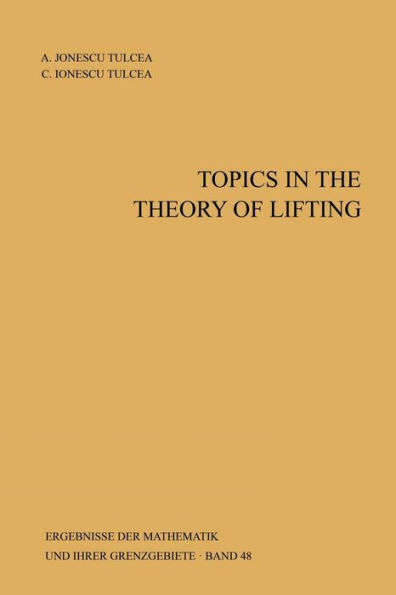5
1

Topics in the Theory of Lifting
192
by Alexandra Ionescu Tulcea, C. Ionescu Tulcea
Alexandra Ionescu Tulcea

Topics in the Theory of Lifting
192
by Alexandra Ionescu Tulcea, C. Ionescu Tulcea
Alexandra Ionescu Tulcea
Paperback(Softcover reprint of the original 1st ed. 1969)
$54.99
-
PICK UP IN STORECheck Availability at Nearby Stores
Available within 2 business hours
Related collections and offers
54.99
In Stock
Overview
The problem as to whether or not there exists a lifting of the M't/. 1 space ) corresponding to the real line and Lebesgue measure on it was first raised by A. Haar. It was solved in a paper published in 1931 [102] by 1. von Neumann, who established the existence of a lifting in this case. In subsequent papers J. von Neumann and M. H. Stone [105], and later on 1. Dieudonne [22], discussed various algebraic aspects and generalizations of the problem. Attemps to solve the problem as to whether or not there exists a lifting for an arbitrary M't/. space were unsuccessful for a long time, although the problem had significant connections with other branches of mathematics. Finally, in a paper published in 1958 [88], D. Maharam established, by a delicate argument, that a lifting of M't/. always exists (for an arbi trary space of a-finite mass). D. Maharam proved first the existence of a lifting of the M't/. space corresponding to a product X = TI {ai,b,} ieI and a product measure J.1= Q9 J.1i' with J.1i{a;}=J.1i{b,}=! for all iE/. ,eI Then, she reduced the general case to this one, via an isomorphism theorem concerning homogeneous measure algebras [87], [88]. A different and more direct proof of the existence of a lifting was subsequently given by the authors in [65]' A variant of this proof is presented in chapter 4.

Product Details
| ISBN-13: | 9783642885099 |
|---|---|
| Publisher: | Springer Berlin Heidelberg |
| Publication date: | 03/17/2013 |
| Series: | Ergebnisse der Mathematik und ihrer Grenzgebiete. 2. Folge , #48 |
| Edition description: | Softcover reprint of the original 1st ed. 1969 |
| Pages: | 192 |
| Product dimensions: | 5.98(w) x 9.02(h) x 0.02(d) |
Table of Contents
I. Measure and integration.- 1. The upper integral.- 2. The spaces—p and Lp (1— p < +—).- 3. The integral.- 4. Measurable functions.- 5. Further definitions and properties of measurable functions and sets.- 6. Carathéodory measure.- 7. The essential upper integral. The spaces M? and L?.- 8. Localizable and strictly localizable spaces.- 9. The case of abstract measures and of Radon measures.- II. Admissible subalgebras and projections onto them.- 1. Admissible subalgebras.- 2. Multiplicative linear mappings.- 3. Extensions of linear mappings.- 4. Projections onto admissible subalgebras.- 5. Increasing sequences of projections corresponding to admissible subalgebras.- III. Basic definitions and remarks concerning the notion of lifting.- 1. Linear liftings and liftings of an admissible subalgebra. Lower densities.- 2. Linear liftings, liftings and extremal points.- 3. On the measurability of the upper envelope. A limit theorem.- IV. The existence of a lifting.- 1. Several results concerning the extension of a lifting.- 2. The existence of a lifting of M?.- 3. Equivalence of strict localizability with the existence of a lifting of M?.- 4. Non-existence of a linear lifting for the—p spaces (1— p <—).- 5. The extension of a lifting to functions with values in a completely regular space.- V. Topologies associated with lower densities and liftings.- 1. The topology associated with a lower density.- 2. Construction of a lifting from a lower density using the density topology.- 3. The topologies associated with a lifting.- 4. An example.- 5. Liftings compatible with topologies.- 6. A remark concerning liftings for functions with values in a completely regular space.- VI. Integrability and measurability for abstract valued functions.- 1. The spaces—EP and LEP (1— p < +—).- 2. Measurable functions.- 3. Further definitions and properties. The spaces—E? and LE?.- 4. The spaces MF? [G] and LF? [G].- 5. The case of the spaces ME? [E] and LE? [E].- 6. The spaces—EP [E] and LEP [E] (1— p < +—).- 7. A remark concerning the space MF? [G].- VII. Various applications.- 1. An integral representation theorem.- 2. The existence of a linear lifting of MR? is equivalent to the Dunford-Pettis theorem.- 3. Remarks concerning measurable functions and the spaces ME? [E?] and LE? [E?].- 4. The dual of LE1.- 5. The dual of LEP (1 < p < +—).- 6. A theorem of Strassen.- 7. An application to shastic processes.- VIII. Strong liftings.- 1. The notion of strong lifting.- 2. Further results concerning strong liftings. Examples.- 3. An example and several related results.- 4. The notion of almost strong lifting.- 5. The notions of almost strong and strong lifting for topological spaces.- Appendix. Borel liftings.- IX. Domination of measures and disintegration of measures.- 1. Convex cones of continuous functions and the domination of measures.- 2. Disintegration of measures. The case of a compact space and a continuous mapping.- 3. The cones F (T,—+(S), µ) and F? (T,—+(S), µ).- 4. Integration of measures.- 5. Disintegration of measures. The general case.- X. On certain endomorphisms of LR?(Z, µ).- 1. The spaces R(I1, I2).- 2. The sets U(I1, I2) and the mappings—u.- 3. The first main theorem.- 4. The spaces U*(I1, I2).- 5. A condition equivalent with the strong lifting property.- Appendix I. Some ergodic theorems.- Appendix II. Notation and terminology.- Open Problems.- List of Symbols.From the B&N Reads Blog
Page 1 of
